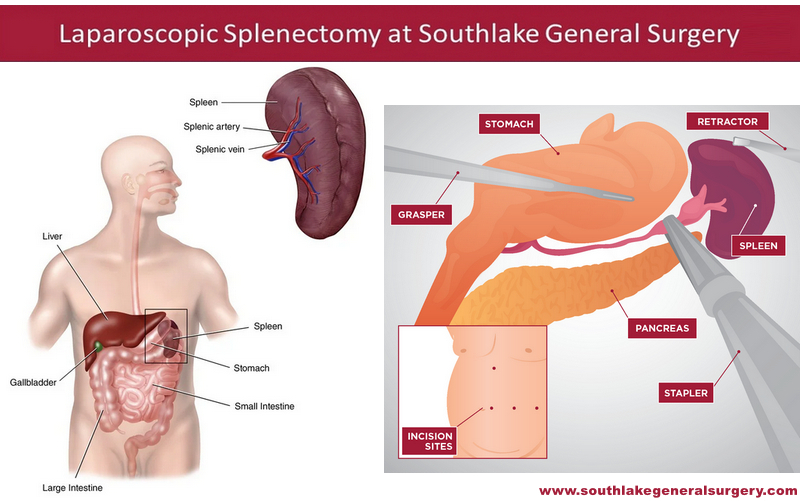To remove the entire spleen splenectomy surgery or Laparoscopic splenectomy is performed. The spleen is a delicate fist-sized organ located under the left rib cage close to the stomach. The spleen is a significant part of the body’s immune system. It also helps remove and filter old red blood cells from the blood.
At times, only a part of the spleen is removed and this procedure is called partial splenectomy.
As compared to some other organs like the liver, the spleen doesn’t grow back once it is removed.
Approximately, 30% of individuals have a secondary spleen (known as an accessory spleen). These are typically very small in size, however, they may develop and function in the same way when the primary spleen is removed from the body. It’s very rare that a piece of the spleen may break off with an injury, for example, a car accident injury. In the event that the spleen is expelled, this piece can grow and work.
Why do you need a Splenectomy?
You might have to remove the spleen if you met with an injury that has damaged the organ, making its covering tear open or rupture. A ruptured spleen can cause serious complications and even lead to life-threatening internal bleeding. A ruptured spleen can happen with common-injury including car or motorbike accidents and extreme hits to the abdomen during outdoor sports such as hockey, rugby, or football.
A splenectomy may likewise be recommended if you are suffering from cancer or any other disease that affects blood cells in the body. Many conditions can make the spleen swell, making the organ progressively delicate and allowing it to get rupture. In a few instances, an ailment, for example, sickle cell disease, can make the spleen wither up and stop functioning. This is condition is known as auto-splenectomy.
Other common factors an individual may require a spleen removal include:
Blood disorders:
- Ancestral elliptocytosis (ovalocytosis)
- Ancestral nonspherocytic hemolytic anemia
- Hereditary spherocytosis
- Thalassemia (Mediterranean anemia, or Thalassemia major)
Blood vein problems:
- Aneurysm in the spleen’s artery
- Blood clot in the spleen’s blood veins
Cancer disease:
- Leukemia: a type of blood cancer that influences cells that help the body fight against infections.
- Many forms of lymphoma and cancer influences cells that help the body fight against infections.
Other factors:
- Cyst or ulcer (gathering of pus) in the spleen
Prior to a Splenectomy
If the doctor thinks there is a ruptured spleen and you have indications of enormous internal bleeding or precarious imperative signs, for example, low blood pressure, you will probably have spleen surgery immediately.
Splenectomy Treatment at Southlake General Surgery
The doctor will give you general anesthesia a couple of moments prior to surgery to avoid any painful conditions during the operation.
There are two different procedures to perform a splenectomy:
- Laparoscopic splenectomy &,
- Open Splenectomy Surgery
Laparoscopic Splenectomy
Laparoscopic splenectomy is performed using an instrument known as a laparoscope. It’s a very thin piece of equipment with a micro mini camera and a light on the end. Under Laparoscopic splenectomy, the surgeon makes 3-4 small incisions on the abdomen and inserts the Laparoscope to view inside your abdomen to locate the spleen. The surgeon removes the spleen from surrounding structures and the blood supply of the body. Once the spleen is removed surgeon closes the incision with sutures.
In rare conditions, the surgeon might have to switch from laparoscopic splenectomy to the open procedure. This is usually when you have an excessive bleeding problem during the surgery.
Open splenectomy
In an open splenectomy, the surgeon makes a large incision as an entry point to the center or left side of the abdomen underneath the rib cage. After identifying the spleen, the surgeon removes the spleen from the pancreas and the blood supply of the body and finally removes the spleen from the body. Once the spleen is removed surgical incision is closed with stitches or sutures.
After Splenectomy Take Precautions To Avoid Infections
To avoid developing bacterial infections in children and adults it is important to take antibiotics as prescribed by the doctor after the removal of the spleen. For individuals who are planning to travel abroad or to a place where medical help might not be easily accessible after Splenectomy surgery, it is recommended to carry prescribed antibiotics along. Also for the individual who had spleen surgery, please consult your doctor for flu shots each year.
Appointment
For more information on the removal of the spleen or Laparoscopic splenectomy, treatment, diet plan, and consultation with Dr. Valeria Simone MD, at Southlake General Surgery, Texas, USA. Please connect with our healthcare expert today +1(817) 748-0200

